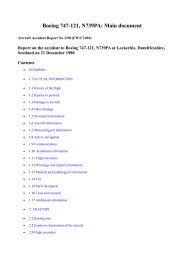REPORT OF THE - Archives - Syracuse University
REPORT OF THE - Archives - Syracuse University
REPORT OF THE - Archives - Syracuse University
You also want an ePaper? Increase the reach of your titles
YUMPU automatically turns print PDFs into web optimized ePapers that Google loves.
The flight deck and forward portion of "Maid of the Seas" came to rest in Tundergarth<br />
Field, approximately three miles from Lockerbie, Scotland.<br />
Sections of the aircraft fell upon and around the quiet town of Lockerbie, in the rolling<br />
hills of Scotland. The wings and attached fuselage section plummeted into the edge of the<br />
town, gorging a crater 140 feet long and 40 feet wide and exploding into a fireball that<br />
towered 10,000 feet. A piece of window frame from a nearby house landed three miles<br />
away. Winds scattered debris from the aircraft all the way to the coast of England, 80<br />
miles to the east.<br />
The worst security-related disaster in U.S. civil aviation history had happened. All aboard<br />
the plane and 11 residents of Lockerbie perished.<br />
The Aftermath<br />
An immense investigation immediately began in Lockerbie to establish the cause of the<br />
aircraft's destruction. The investigators would eventually conclude that an explosive<br />
device utilizing a plastic explosive was likely concealed in a radio cassette recorder<br />
carried within a suitcase stowed in the cargo hold.<br />
A huge effort by the citizens of Lockerbie also began in order to deal with the aftermath<br />
of the tragedy. Personnel from Pan Am and Boeing among many others arrived at<br />
Lockerbie, as did officers from the U.S. Department of State. State Department activities<br />
will be reviewed in Chapter 7 of this Report. Representatives from the Federal Bureau of<br />
Investigation also arrived to assist in the investigation. The Central Intelligence Agency<br />
told the Commission that it did not send anyone to the site.<br />
Through an emergency rule-making, the FAA amended the Air Carrier Standard Security<br />
Program in the days after the Lockerbie atrocity. By December 31, 1988, all affected<br />
carriers were required to meet more stringent requirements, including total reconciliation<br />
between passengers and checked baggage. Under the new standard, bags could not fly<br />
unless specifically matched with a passenger. There could be no more "extra" bags. Pan<br />
Am implemented the procedure at Frankfurt on January 4, 1989.<br />
The FAA also began its own special investigation of the Pan Am procedures at Frankfurt<br />
and Heathrow. The Frankfurt phase was completed by mid-January, and the Heathrow<br />
review by the end of January. The inquiries covered the six-week period beginning on<br />
December 21, 1988.<br />
Upon leaving Frankfurt and Heathrow the FAA inspectors, as was customary, briefed Pan<br />
Am on their findings. The first deficiency noted in Frankfurt was that the passenger/bag<br />
match system in place for interline bags was "inadequate." The investigators told Pan Am<br />
they had found that "interline bags were X-rayed only with no correlation between the<br />
passenger boarding the aircraft and the bag being placed on board."<br />
In late January and early February 1989, the FAA sent teams of investigators on<br />
"determination trips," intended to assess how carriers were complying with the new<br />
procedures the FAA had mandated at the end of December 1988. While at the airports in<br />
Frankfurt and London, the determination teams decided to conduct full compliance<br />
inspections of Pan Am as well.<br />
The January inspection at Frankfurt revealed that many of the same problems existing on<br />
December 21, 1988, continued uncorrected. Deficiencies included no written bag match<br />
procedures; no challenging of unbadged personnel; inadequate tracking of passenger<br />
screening; failure to secure gates or ramps, and failure to search servicing personnel. An










